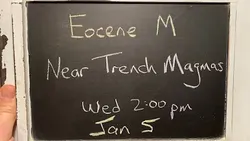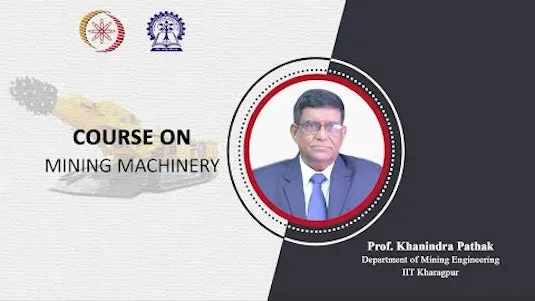
Eocene M - Near Trench Magmas w& Jeff Tepper 
This lecture by Jeff Tepper explores the similarities and differences between three magmatic flare ups in the North Cascade region: Cretaceous Plutons, Eocene Plutons, and the In Between Plutons. Nick's Hammer is used to provide an overview of the Eocene M - Near Trench Magmas. Through this lecture, Tepper provides insight into the geological history of the region. ▼
ADVERTISEMENT
Course Feature
![]() Cost:
Cost:
Free
![]() Provider:
Provider:
Youtube
![]() Certificate:
Certificate:
Paid Certification
![]() Language:
Language:
English
![]() Start Date:
Start Date:
On-Demand
Course Overview
❗The content presented here is sourced directly from Youtube platform. For comprehensive course details, including enrollment information, simply click on the 'Go to class' link on our website.
Updated in [February 21st, 2023]
In this course, Jeff Tepper and Nick's Hammer will provide an overview of the North Cascade Magmatic Flare Ups, Cretaceous Plutons, and Eocene Plutons. They will discuss the similarities and differences between the three flare ups, as well as how the magmas are being generated. The course will also include a Slab Failure Animation, North Cascades Geologic Maps and Photos, a Modern Volcanic Arc, and a Near Trench Magmas (NTM) overview. Jeff Tepper will provide examples of NTM, as well as how to tell NTMs apart from Slab Window and Arc Magmas. Nick's Hammer will discuss Plichuck and Bald Mtn Results from Slab Failure, as well as the differences between the Magmatic Flare Ups. There will be a Q&A session with both Jeff and Nick, followed by a toast and goodbye.
[Applications]
After taking this course, students should be able to apply their knowledge of Eocene M - Near Trench Magmas to understand the similarities and differences between the three flare ups, how magmas are being generated, and how to tell NTMs apart. They should also be able to identify North Cascades geologic maps and photos, modern volcanic arcs, forearcs, slab windows, and Adakite. Additionally, they should be able to interpret the results from Slab Failure at Plichuck and Bald Mtn.
[Career Paths]
1. Geologist: Geologists study the physical structure and composition of the Earth, including its rocks, minerals, and other materials. They use their knowledge to explore for natural resources, such as oil and gas, and to assess the environmental impact of human activities. Geologists are in high demand due to the increasing need for energy resources and the need to understand the effects of climate change.
2. Geophysicist: Geophysicists use physical principles to study the Earth's interior and its atmosphere. They use seismic, magnetic, and gravity data to map the Earth's structure and to study the Earth's magnetic and gravitational fields. Geophysicists are in high demand due to the need to understand the effects of climate change and to explore for natural resources.
3. Petroleum Engineer: Petroleum engineers design and develop methods for extracting oil and gas from the Earth. They use their knowledge of geology, chemistry, and physics to develop new technologies and techniques for extracting oil and gas. Petroleum engineers are in high demand due to the increasing need for energy resources.
4. Environmental Scientist: Environmental scientists study the effects of human activities on the environment. They use their knowledge of biology, chemistry, and geology to assess the impact of human activities on the environment and to develop strategies for protecting the environment. Environmental scientists are in high demand due to the need to understand the effects of climate change and to develop strategies for protecting the environment.
[Education Paths]
1. Geology: Geology is the study of the Earth, its composition, structure, and history. It is a field of science that is constantly evolving as new technologies and discoveries are made. Geologists use a variety of tools and techniques to study the Earth, including field mapping, laboratory analysis, and remote sensing. Geology degrees are available at the undergraduate and graduate levels, and can lead to careers in research, teaching, and industry.
2. Geophysics: Geophysics is the study of the physical properties of the Earth, such as its gravity, magnetic fields, and seismic activity. Geophysicists use a variety of tools and techniques to study the Earth, including seismic surveys, gravity surveys, and magnetometry. Geophysics degrees are available at the undergraduate and graduate levels, and can lead to careers in research, teaching, and industry.
3. Geochemistry: Geochemistry is the study of the chemical composition of the Earth, its rocks, and its minerals. Geochemists use a variety of tools and techniques to study the Earth, including laboratory analysis, field mapping, and remote sensing. Geochemistry degrees are available at the undergraduate and graduate levels, and can lead to careers in research, teaching, and industry.
4. Environmental Science: Environmental Science is the study of the environment and its interactions with humans and other organisms. It is a field of science that is constantly evolving as new technologies and discoveries are made. Environmental Science degrees are available at the undergraduate and graduate levels, and can lead to careers in research, teaching, and industry.
Course Provider

Provider Youtube's Stats at AZClass
Discussion and Reviews
0.0 (Based on 0 reviews)
Explore Similar Online Courses

Build An Email List & Online Business Fast!

CLEP American Literature: Study Guide & Test Prep

Python for Informatics: Exploring Information

Social Network Analysis

Introduction to Systematic Review and Meta-Analysis

The Analytics Edge

DCO042 - Python For Informatics

Causal Diagrams: Draw Your Assumptions Before Your Conclusions

Whole genome sequencing of bacterial genomes - tools and applications

Mining Engineering

The Future of Mining?


Start your review of Eocene M - Near Trench Magmas w& Jeff Tepper